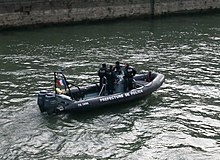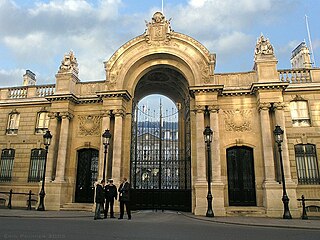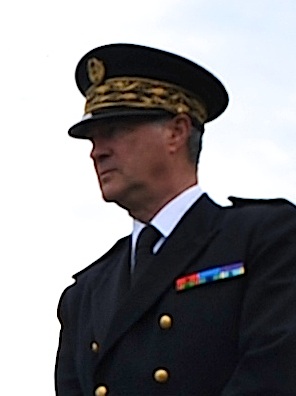You can help expand this article with text translated from the corresponding article in French. (September 2021)Click [show] for important translation instructions.
|
This article needs additional citations for verification .(January 2017) |
| Préfecture de police | |
|---|---|
 Logo | |
| Agency overview | |
| Formed | 1667 Dissolved in 1789, refounded in 1800 |
| Jurisdictional structure | |
| Operations jurisdiction | Paris & Petite Couronne in the Île-de-France region, France |
 | |
| Map of Préfecture de police's jurisdiction | |
| Size | 762 km² |
| Population | 6,673,591 (Jan. 1, 2010) |
| Operational structure | |
| Headquarters | Paris |
| Sworn members | 34,000 |
| Agency executive |
|
| Districts | 15 |
| Facilities | |
| Stations | 87 |
| Website | |
| Préfecture de Police | |

The Paris Police Prefecture (French : préfecture de police de Paris [pʁefɛktyʁdəpɔlisdəpaʁi] ), officially the Police Prefecture (French : préfecture de police), is the unit of the French Ministry of the Interior that provides police, emergency services, and various administrative services to the population of the city of Paris and the surrounding three suburban départements of Hauts-de-Seine, Seine-Saint-Denis, and Val-de-Marne. It is headed by the Paris Prefect of Police (le Préfet de police de Paris), officially called the Prefect of Police (le Préfet de police).
Contents
- Jurisdiction
- Nomination and missions
- Address
- Organization
- Prefect and Director of the Cabinet
- Prefect and Secretary-General for the Administration of the Police
- Prefect and Secretary-General for the Zone of Defence
- Resources
- Activities
- List of lieutenant generals and prefects of police
- Lieutenant generals of police
- Prefects of police
- See also
- References
- External links
The Paris Police Prefecture supervises the Paris Police force, the Paris Fire Brigade, and various administrative departments in charge of issuing ID cards and driver licenses or monitoring alien residents. The Prefecture of Police also has security duties in the wider Île-de-France région as the Préfet de Police is also Préfet de Zone de Défense (Prefect for the Defense zone). [1] Since 2017, it has acquired direct responsibility for the three main airports of the Paris area (Charles de Gaulle, Orly and Le Bourget).
In addition to the Préfecture de Police, the French government created the Paris Municipal Police (French : Police municipale de Paris ) in 2021. In contrast with the Préfecture, the municipal police report to the city government, rather than to the national government. Municipal police officers began patrolling city streets on foot, bicycle, and by car starting on October 18, 2021. The goal of the municipal police is to "make neighbourhoods safer and more peaceful and ensure that public space is shared," for example by enforcing laws on parking, littering, breaking up quarrels, and assisting homeless or elderly residents. [2]
The préfecture [3] is a large building located in the Place Louis Lépine on the Île de la Cité. This building was built as a barracks for the Garde républicaine from 1863 to 1867 (architect Pierre-Victor Calliat) and was occupied by the Prefecture in 1871.
As it is the capital of France, with government assemblies and offices and foreign embassies, Paris poses special issues of security and public order. Consequently, the national government has been responsible for providing law enforcement and emergency services since the creation of the Lieutenancy General of Police (lieutenance générale de police) by Louis XIV on March 15, 1667. Disbanded at the start of the French Revolution in 1789, it was replaced by the current Prefecture of Police created by Napoléon I on February 17, 1800. This means that, up until 2021, Paris did not have its own police municipale and that the Police Nationale provided all of these services directly as a subdivision of France's Ministry of the Interior.
Policemen assigned to "la PP" are part of the Police nationale but the Police Prefect reports directly to the Interior Minister, not to the director of the Police nationale (Directeur général de la Police nationale or DGPN). In Parisian slang, the police were sometimes known as "the archers", a very old slang term in reference to the archers of the long-defunct Royal Watch.
Paris also has the "Direction de la Prévention, de la Sécurité et de la Protection" (DPSP) (Prevention, Security and Protection Directorate) which is composed of Agents with municipal police powers [4] titled inspecteurs de sécurité (Security Inspectors). [5] The DPSP reports to the Mayor of Paris.



















